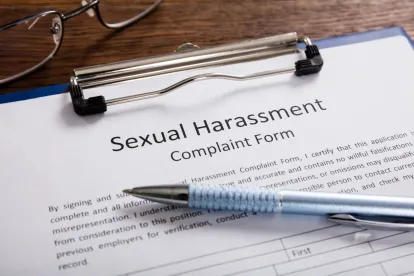Introduction
The Equal Employment Opportunity Commission (“EEOC”) has released its Preliminary Fiscal Year 2018 Sexual Harassment Data (“Preliminary Data”), showing a significant increase in workplace harassment lawsuits. The release of the Preliminary Data arrives on the heels of the final report (the “Report”) of the EEOC’s Select Task Force on the Study of Harassment in the Workplace (the “Task Force”), which focused on the root causes of workplace harassment. To assist employers with their ongoing obligation to protect employees from workplace harassment, this Alert summarizes the information and guidance provided in the Report, including identification of the risk factors for harassment in the workplace, and includes the newest guidance from the EEOC regarding effective anti-harassment policies.
1. Background on the Report and the Preliminary Data
The Report was the culmination of a three-year effort led by EEOC Commissioners Chai R. Feldblum and Victoria A. Lipnic, reportedly in response to the number of harassment claims the EEOC has been receiving. EEOC Chair Jenny Yang created the Task Force in 2015 and charged it with seeking and reporting answers to the fundamental questions of why harassment continues to take place and what can be done to prevent it.
According to the Report, the Task Force gathered information through research, interviews, testimony, and reports from management and plaintiffs’ attorneys, representatives of employee and employer advocacy groups, labor representatives, and academics who studied the field for years, including sociologists, psychologists, and experts in organizational behavior. The Task Force held public forums, gave presentations, and held working sessions in cities around the United States to gather information. The Task Force examined the problem of workplace harassment in all of its forms, identified several areas of existing weakness, and looked for ways by which it might be prevented. This inquiry was not limited to the “legal” definition of harassment but instead covered any unwelcome or offensive conduct in the workplace that is: (a) based on sex (including sexual orientation, pregnancy, and gender identity), race, color, national origin, religion, age, disability, and/or genetic information; and (b) detrimental to an employee’s work performance, professional advancement, and/or mental health.
The Preliminary Data also reflects the current emphasis on harassment issues. It shows that the EEOC filed more than twice as many sexual harassment suits in its 2018 fiscal year than it did in 2017, and that sexual harassment charges filed with the EEOC increased by 12 percent over the same period. Overall, the EEOC recovered nearly $70 million for sexual harassment claimants through litigation and administrative enforcement in fiscal year 2018, up from $47.5 million in fiscal year 2017. The Report emphasizes that employers spend precious time, energy, and resources on employment claims. According to a study by one liability insurance provider, roughly 19 percent of employment claims were settled with the cost of defense and settlement hovering around $125,000 per claim, and the average time for resolution of non-meritorious claims that did not result in a settlement payment was 275 days.
2. Risk Factors for Harassment and What to Do About Them
The Report highlights certain factors relating to work environments and organizational structures that the EEOC has now identified as predictors of whether harassment will occur. While the full list can be found here, there are several particularly important characteristics detailed below of which employers should be mindful.
-
Risk Factor #1: Homogenous workplaces or workplaces with an established “norm”. Workplaces lacking in diversity have a higher risk of harassment.
Recommended Steps: Pay attention to how employees interact with one another, create a culture of civility and respect, and focus on improving diversity.
-
Risk Factor #2: Cultural or language differences in the workplace. On the opposite end of the spectrum, workplaces with blocs of diverse individuals are at risk of harassment. Additionally, language barriers or cultural differences may prevent a clear understanding of what is prohibited conduct or what to do if harassing behavior occurs.
Recommended Steps: Be aware of any segregation across the workforce, establish guidelines for appropriate workplace conduct, and ensure reporting channels are clearly communicated.
-
Risk Factor #3: Power disparities and “high-value” employees. Though power disparities between groups of employees are often an unavoidable organizational reality, employers should be aware of the effect such dynamics in the workplace can have on harassment. Employees in a position of authority may feel empowered to exploit subordinate employees, and lower-level workers may be hesitant to report for fear of retaliation. If an employee brings real or perceived “high value” to the company, management may be reluctant to jeopardize that value.
Recommended Steps: Ensure policies are applied uniformly regardless of employee position and ensure employees of all levels are aware of available reporting avenues.
-
Risk Factor #4: Isolated or decentralized workplaces. Physically isolated workplaces or environments where offices are far removed from management may give harassers easy access to targets, especially with no supervisor to hold the harasser accountable for such behavior.
Recommended Steps: Ensure anti-harassment training and reporting procedures reach all employees, regardless of how geographically dispersed workplaces may be.
-
Risk Factor #5: Workplaces where work is monotonous or where there are low-intensity tasks. If employees are not engaged in their work, harassing behavior may become a way to vent frustration or combat boredom.
Recommended Steps: Pay attention to relations among and within work groups with low-intensity or monotonous responsibilities.
-
Risk Factor #6: Workplaces that rely on customer service or client satisfaction. For employees whose compensation is directly tied to customer satisfaction or client service, the fear of losing a sale or other compensation may force them to tolerate harassing behaviors.
Recommended Steps: Stress the importance of workplace safety, encourage employees to be wary of unwelcome conduct, and frequently remind employees that they are never expected to tolerate such behavior.
-
Risk Factor #7: Alcohol consumption. Alcohol reduces social inhibitions and impairs judgment, which may cause employees to act outside the bounds of acceptable workplace behavior.
Recommended Steps: Train supervisors and employees to intervene promptly when customers, clients, or coworkers who have consumed too much alcohol act inappropriately.
-
Risk Factor #8: Social discourse outside the workplace. Current events happening outside the workplace may affect behavior inside the workplace. Targeted harassment may increase or be perceived as acceptable in response to current events.
Recommended Steps: Proactively identify current events that are likely to impact behavior in the workplace and address those issues constructively with employees (e.g., group trainings and discussions).
-
Risk Factor #9: Young workforces. Young employees may be less aware of laws and workplace norms. According to the Report, they are more likely to be harassed and also more likely to be harassers. They may be a target because they are susceptible to being taken advantage of and are afraid to challenge inappropriate conduct. They are also more likely to engage in harassing conduct because they may not have the maturity to understand the consequences of inappropriate workplace behavior.
Recommended Steps: Ensure all new employees are trained on workplace conduct, given the anti-harassment policy, and taught to utilize the complaint process.
3. Effective Anti-Harassment Training and Policies
According to the Report, workplace culture has the biggest impact on creating an environment that either prevents or tolerates harassment. Leaders that are committed to an inclusive, diverse, respectful workforce help cultivate a culture that promotes a harassment-free workplace. Employers are encouraged to use the EEOC’s new Checklist for Employers on Leadership and Accountability to create a holistic harassment prevention program and establish a culture of respect in which harassment is not tolerated at the organization.
As employers know, establishing effective and well-tailored policies and procedures is essential to mitigating the risk of harassment. Employers are further advised to consider the EEOC’s new Checklists for Employers on Anti-Harassment Policy, Harassment Reporting Systems and Investigations, and Compliance Training to focus on anti-harassment efforts beyond the scope of purely litigation avoidance and instead on the prevention of all types of harassing behaviors, whether legally actionable or not. Importantly, the Report makes clear that multiple avenues for reporting should be available to both victims and observers of harassment. As always, employers should ensure that when a complaint of harassment is made, it is handled promptly, objectively, and thoroughly to prevent the appearance of tolerating such behavior. Once an incident has been brought to the employer’s attention, the employer should remain alert to any possibility of retaliation against the reporting employee.
Conclusion
The EEOC’s Preliminary Data indicates that employers should expect a continued increase in complaints of sexual harassment in the workplace. The Report contains a wealth of information and guidance to assist employers in responding to and preventing harassment in the workplace, as well as many useful new checklists for employers to confirm compliance with the Task Force’s recommended best practices. To proactively identify and combat workplace harassment, and be in the best possible footing in the event of a claim, employers should consider conducting internal analyses of risk factors for harassment and implementing effective anti-harassment training and policies in light of those risks. Experienced counsel can help businesses navigate these issues and craft policies and reporting procedures that are precisely tailored to any company’s needs.
Thank you to K&L Gates Summer Associate Avery Barber for her assistance in preparing this article.





 />i
/>i
